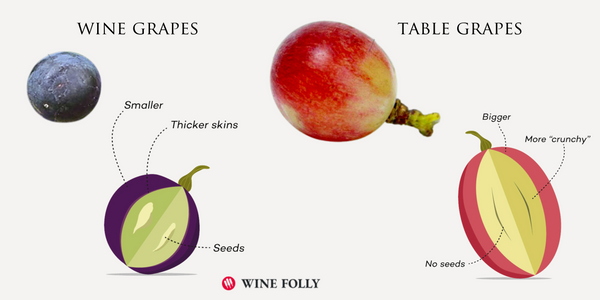Unraveling the Grape Mystery: Wine Grapes vs. Table Grapes
Have you ever found yourself standing in the produce aisle, gazing at those plump, juicy table grapes, and pondering, "Could I transform these into a splendid bottle of wine?" If so, you're not alone in your grape-induced musings. The perpetual question of what distinguishes these two grape varieties has intrigued many, but fear not, for we're about to shed light on this fruity enigma.
Let's embark on our grape journey by exploring their origins. Wine grapes, the esteemed ancestors of our favourite vintages, trace their lineage back to the Vitis Vinifera species. Originating from the sun-drenched lands of the Mediterranean, they've long been revered by winemakers worldwide. On the flip side, table grapes can arise from various species such as Vitis Labrusca and Vitis Rotundifolia, ideal for casual consumption but not quite suited for the winemaking craft.
Now, prepare to dive skin-deep into the grape realm. Picture those delightful table grapes with their tender, easily bitten skins. While they're perfect for casual snacking, they lack the robustness required for winemaking. Enter wine grapes, boasting thicker skins akin to protective armour. These resilient skins play a crucial role in imparting tannins and that rich crimson hue to our beloved reds.
Now, brace yourselves for a grape plot twist—sweetness. Contrary to popular belief, wine grapes reign supreme in sweetness. Why? Because when it comes to crafting a great wine, sugar is the essential catalyst for fermentation. Meanwhile, table grapes, while delightful for snacking, simply can't match the sweetness required for fermentation. It's all about that sugar rush for the fermentation process!
Size matters, they say, and oh, how it does in the grape universe. While wine grapes may be modest in size, they pack a flavourful punch that's eagerly waiting to be unleashed. Their compact nature allows for concentrated flavours, making them ideal for the alchemy of winemaking. Conversely, table grapes flaunt their larger-than-life proportions, brimming with hydration but lacking the flavour intensity of their wine grape counterparts.

And now, onto yield—the final act in the grape grower's saga. In the realm of winemaking, quality often triumphs over quantity. Winemakers treat their vines with reverence, coaxing only a modest yield per vine to ensure unparalleled quality in every bottle. Meanwhile, table grape producers adopt a different approach, employing trellis systems to maximize yield and deliver ample clusters of grapes. While this abundance brings joy to snack time, it's not conducive to crafting exceptional wines.
So there you have it—the grapevine has spoken! Wine grapes and table grapes may share a common ancestry, but they embark on divergent paths, each with its own role in the grand tapestry of viticulture. So, next time you raise a glass of your favourite vintage, salute the humble grape, for it's the true hero of the vineyard narrative, whether destined for your wine glass or your fruit bowl. Here's to grapes, in all their juicy glory! 🍇🍷
1 comment
Love this!! Very well written.
